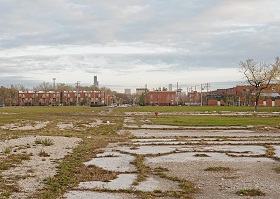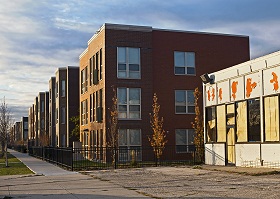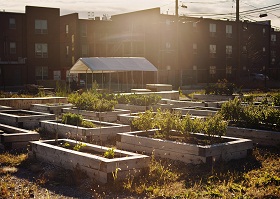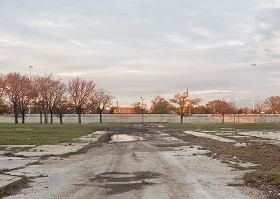Photographers give Illinois prisoners a glimpse of the outside world
By Lauren Chooljian

Photographers give Illinois prisoners a glimpse of the outside world
By Lauren ChooljianOn one of the first really cold November mornings this month, photographer Greg Ruffing was walking around a vacant lot on Chicago’s south side, camera in hand. When he’s shooting photos, he’s all about the details: watching for a train to add movement to the shot. Waiting for the light to shine in precisely the right way.
“It’s definitely really colorful back there,” Ruffing says out loud, scanning the sky. “But it’s a little too dark here in the foreground and a little bit relative to how bright it is in the sky, so I’m just gonna wait a minute.”

“I can’t imagine he has much of a visual reference of what the neighborhood looks like since he’s been gone,” Ruffing muses.
By “gone” Ruffing means locked up in prison since 1976.
Ruffing is one of a group of photographers who are taking pictures for inmates of Tamms, a supermax prison in downstate Illinois.
“A lot of what I’m thinking about is what that experience of sensory deprivation must be like,” Ruffing said. “To not be able to experience little things like leaves crunching under your feet, or little things that we almost take for granted because we experience them every day.”
Ruffing’s photos are part of a projecct run by Tamms Year 10, an advocacy group that’s working to close that prison. The future of Tamms is stuckin a legal battle between Illinois Gov. Pat Quinn’s office and AFSCME, the union that represents the prison employees. Quinn wants it closed, but a judge recently ruled in the union’s favor. The governor’s office has said they’d appeal to the state supreme court.

“That can make a difference in somebody’s life enough that they feel better that day, they’re nicer to a guard that day, you know they have a little more home,” Reynolds said.
The photo project started in late 2010 when Reynolds and other members tucked photo request forms inside holiday cards for the inmates. They asked basic questions: if we could give you a photo of anything, what would you like to see? They got about 50 responses back, and they’re pretty fascinating.
There are the ones you may expect: the Chicago skyline, or Lake Michigan, for example.
And then there are ones like this one: “This person wanted ‘my mother standing in front of a mansion, or Big Castle with a bunch of money on the ground. or if you can’t do that, than substitution is a big mansion or castle with a bunch of money in front of it and a black Hummer parked in front of it.‘”
Or, my personal favorite: “A lovesick clown: holding a old fashioned feathered pen: as if writing a letter: from the waist up: in black and white As close up as possible: as much detail as possible: & the face about 4 inches big.”
There’s even a couple requests for a photo of Mecca.
“We’re having trouble getting someone in Saudi Arabia to fill those,” Reynolds said.
Many of the prisoners asked for pictures of themselves, since most of the inmates only have their mug shot from the Illinois Department of Corrections. Those are the requests that really inspired Angela Jimenez, a freelance photographer from New York who stumbled across the project.
“All the information I had was it’s number 39 and his name is Robert,” Jimenez said. “And he says, ‘I would like my own picture done with an alternate background from the IDOC.com picture. I have no pictures of myself to give to my friends and family.‘”

“And to be honest with you, I did Google it,” she said.
Request number 39 was written by Robert Sauseda. His rap sheet includes two counts of attempted murder, among other things. He’s been incarcerated since 2006.
Jimenez says she had to sit and think about that for a minute.
“Finding out information about them is not necessarily going to warm you up to them, or make you feel like you want to know them personally, it actually complicates it in a way,” she said.
At one point, she asked had to ask herself: why am I doing this?
Jimenez says she decided to focus on what solitary confinement does to the mind, and how her photograph might provide a new mental landscape.
So she went outside her office in Brooklyn and snapped a photo of the blue sky, full of clouds.
Then she photoshopped Sauseda’s mug shot over it – she even personalized it a bit
“I changed his uniform to yellow. I always wear something yellow every day. It kinda lifts my spirits a little bit so I made his shirt yellow,” she said.

“There’s something kind of curious about the anonymity of it – both him not knowing him and him not knowing me that maybe makes the photograph more of a gesture,” Ruffing said.Ruffing says he’s trying to stay out of the personal and political aspects of this assignment as much as possible. But it’s really made him think about the larger issues at play: What does using solitary confinement as punishment say about society?”At some point we have to find a way to identify the things in life that bring us joy, the things that are positive, to help us kind of adapt and get through things,” he said. “I think that’s probably something these prisoners could identify with and probably their victims and their victims’ families could identify with too.”Ruffing says he just hopes his photos could function as an antidote to all this violence.

Two show different views on the vast, empty lot, grass growing out of the old foundation, with the city skyline just barely visible on the horizon.
There’s one that shows the sun just starting to rise on new condos built on State street, and another of a community garden growing behind them.
And finally a tightly-cropped photograph of a stained glass window in a nearby church – almost entirely covered up by a rusty metal screen.
All of the photos will be on display at the School of the Art Institute of Chicago beginning Saturday, November 17th.




